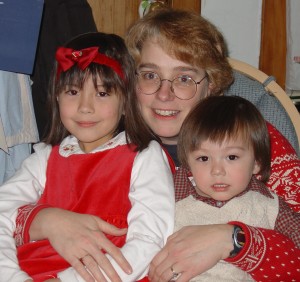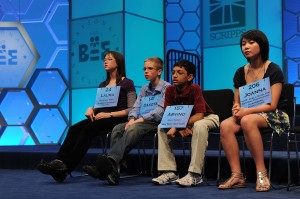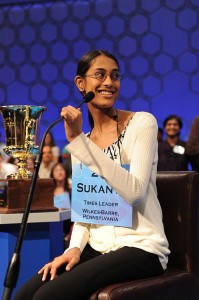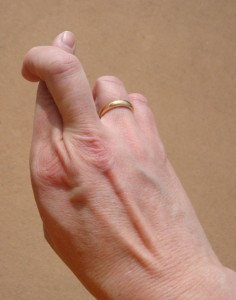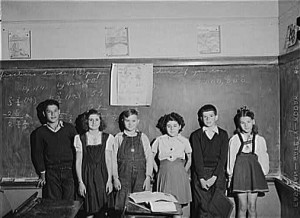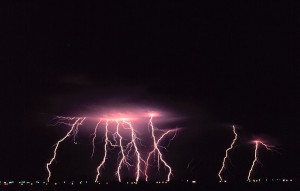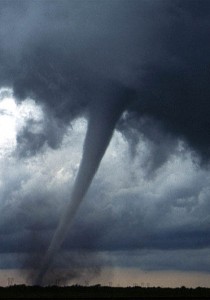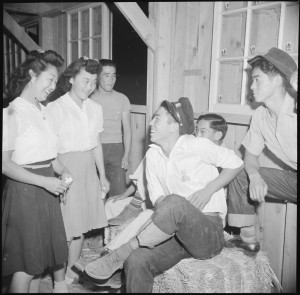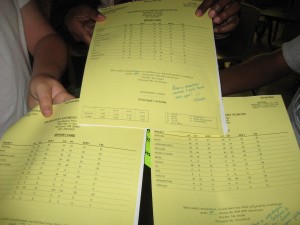1. Where was this picture taken?
This picture was taken inside a house.
2. Who do you see in the picture?
We see a woman (probably a mother) and two children.
3. What are the people in the picture doing?
They are sitting in a chair, having their picture taken.
4. What is Mother’s Day?
Mother’s Day is a day where we honor our mothers, or the mothers in our lives – mothers, grandmothers, mothers-in-law, and mothers-to-be.
5. What is a grandmother?
A grandmother is the mother of your father (paternal grandmother), or the mother of your mother (maternal grandmother).
6. What is a mother-in-law?
A mother-in-law is the mother of your spouse (the mother of your wife/husband).
7. What is a mother-to-be?
A mother-to-be is a woman who is expecting a baby.
8. What is a stepmother?
A stepmother is the wife of your father (i.e., your father has remarried after being widowed or divorced).
9. What can we do to honor our mothers?
We can give our mother a gift, or something that she might like or enjoy. We can do something for her to make her feel special. We can also tell her how much we love her and appreciate her.
10. What kind of presents would be good for Mother’s Day?
Some good presents for Mother’s Day might be flowers, candy, a gift card, or treating her to a meal at a nice restaurant.
11. What is a gift card?
A gift card is a card that contains monetary credit and can be used at a store or restaurant.
12. What is often given with a present?
Oftentimes a card is given with a present.
13. What kind of present might a young child, who usually doesn’t have much money, give to his mother for Mother’s Day?
There are plenty of presents that a young child might give to his mother for Mother’s Day. He can let her sleep in, he can give her breakfast in bed, he can pick some nice flowers from the garden, he can give her a homemade gift or homemade card, or he can give her “coupons” that are good for household chores.
14. Why do you think many people might like to take their mothers out to a restaurant for Mother’s Day?
Many people like to take their mothers out to eat for Mother’s Day as a way of giving their mother a break from the stress of cooking and cleaning for a holiday dinner.
15. If you think the restaurant might be crowded, what should you do in advance?
If you think the restaurant might be crowded, you should make a reservation in advance. Otherwise, you might have to wait for a half-hour or more before the restaurant is able to seat you at a table.
16. What do you call a meal that is neither breakfast nor lunch, but comes between breakfast and lunch?
Brunch is a meal that is neither breakfast nor lunch, but falls between the two. The word is a combination (a portmanteau) of the “br” from breakfast and the “unch” from lunch.
17. Many women like to receive flowers as a present, but unfortunately they don’t last very long. What can we do with flowers to preserve them?
We can preserve flowers by drying them, or pressing them between the pages of a book.
18. Sometimes a local newspaper might have a Mother’s Day contest: Children can complete the sentence, “My mother is the best mother, because __________.” How would you complete the sentence?
One way you could complete the sentence is this: My mother is the best mother, because she is always there to help me and love me when I need her, and she helped to mold me into the person I am today.
19. What might you do for Mother’s Day if your mother has passed away?
If your mother has passed away, you could visit her grave and put some flowers there, as a token of remembrance.
20. Why do you think it is a good idea to show appreciation to your mother on Mother’s Day?
I think it is a good idea to show appreciation to our mothers on Mother’s Day because mothers play an important role not only in the family, but in society as well. The following poem by William Ross Wallace talks about the influence of mothers on society. (The refrain is especially well-known: “…the hand that rocks the cradle is the hand that rules the world.”)
The Hand that Rocks the Cradle is the Hand that Rules the World
Blessings on the hand of women!
Angels guard its strength and grace,
In the palace, cottage, hovel,
Oh, no matter where the place;
Would that never storms assailed it,
Rainbows ever gently curled;
For the hand that rocks the cradle
Is the hand that rules the world.
Infancy’s the tender fountain,
Power may with beauty flow,
Mother’s first to guide the streamlets,
From them souls unresting grow–
Grow on for the good or evil,
Sunshine streamed or evil hurled;
For the hand that rocks the cradle
Is the hand that rules the world.
Woman, how divine your mission
Here upon our natal sod!
Keep, oh, keep the young heart open
Always to the breath of God!
All true trophies of the ages
Are from mother-love impearled;
For the hand that rocks the cradle
Is the hand that rules the world.
Blessings on the hand of women!
Fathers, sons, and daughters cry,
And the sacred song is mingled
With the worship in the sky–
Mingles where no tempest darkens,
Rainbows evermore are hurled;
For the hand that rocks the cradle
Is the hand that rules the world.
~ William Ross Wallace ~
Paragraph: Mother’s Day
When I was a small child, I wanted to get something for my mother for Mother’s Day. However, I didn’t have any money to buy her a present. So I thought about what I could do for her instead. First, I took a piece of paper and a box of crayons, and made a card for her. I drew flowers and hearts on it. Then on the inside I wrote a short note, telling her that she was the best mother ever, and that I loved her so much. After that, I went outside to the garden and picked some flowers for her. I got some lilacs, and made a tiny bouquet of lilies of the valley. When everything was ready, I went to her and told her “Happy Mother’s Day,” giving her my homemade card along with the flowers. She thought the card was lovely, and the flowers beautiful. A little while later, Dad took Mom out to dinner, along with the rest of us. Mom said that she had never had such a nice Mother’s Day.

